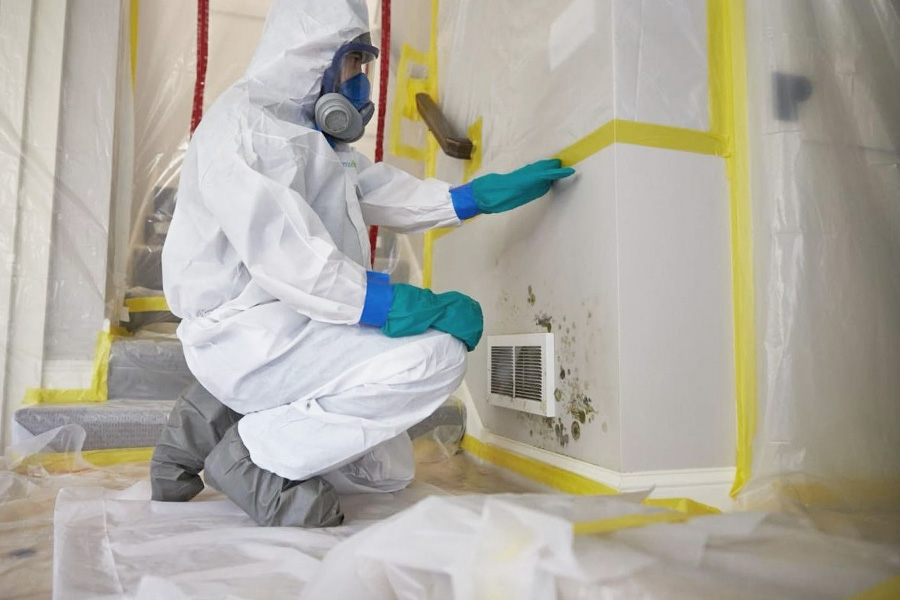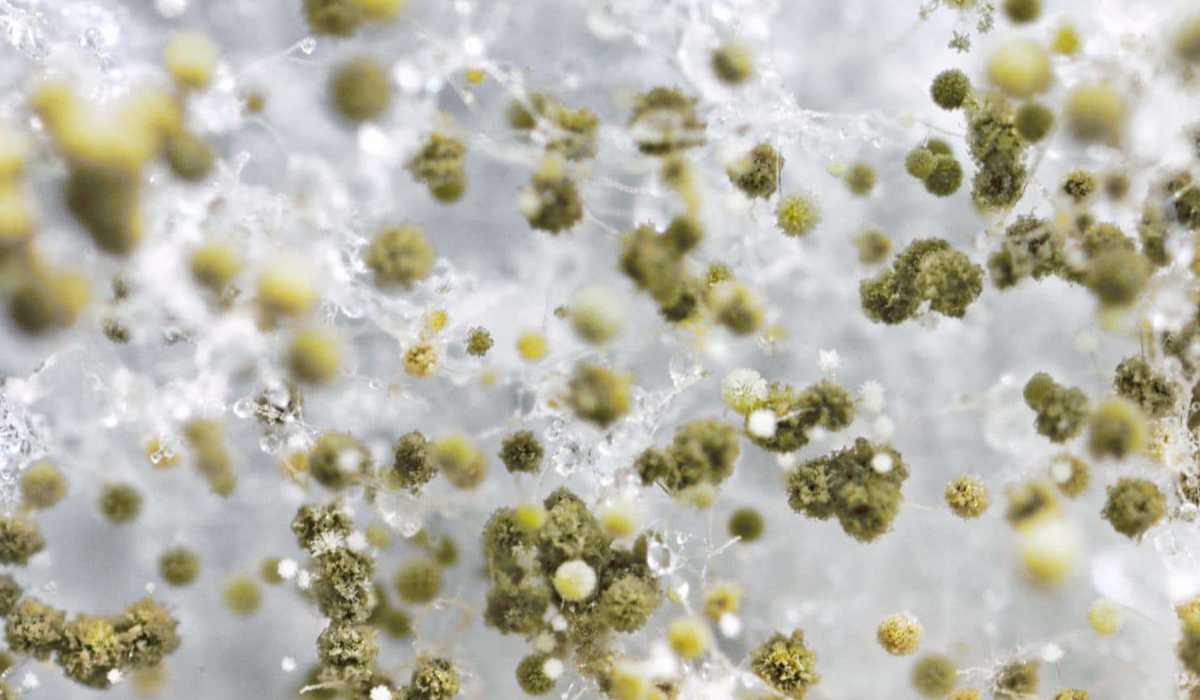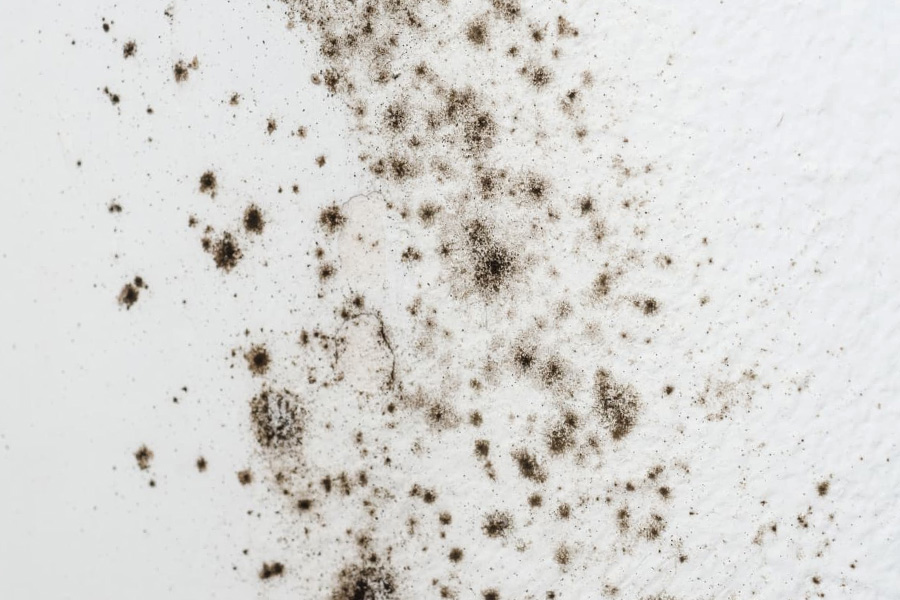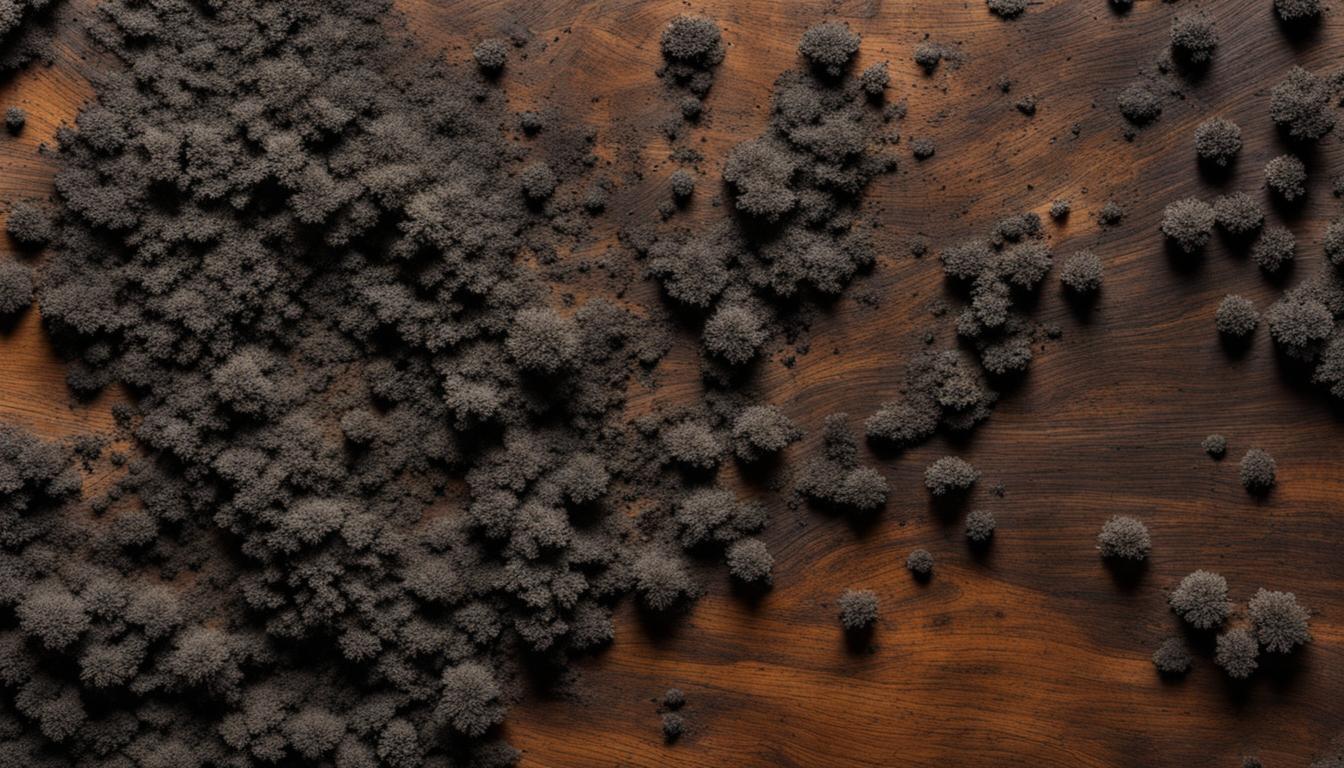
Black Mold on Wood: Causes and Removal Tips
If you have noticed black mold on wood surfaces in your home or office, it is important to take immediate action to address the issue. Black mold growth on wood can lead to structural damage and pose health risks to occupants. In this article, we will explore the causes of black mold on wood and provide effective removal tips to help you eliminate the problem for good.
Key Takeaways:
- Black mold on wood can lead to structural damage and health risks.
- Understanding the causes of mold growth on wood is crucial for effective removal.
- DIY removal methods can be effective for small infestations, but professional mold removal services may be necessary for larger or more severe cases.
- Prevention strategies, such as regular inspection and maintenance, proper ventilation, and addressing water damage and moisture issues, are key to avoiding future mold growth on wood.
- Consulting with professionals and seeking expert guidance is always recommended when dealing with black mold on wood.
Identifying Black Mold on Wood
If you suspect black mold on wooden surfaces, the first step is to identify it accurately. Recognizing the signs of black mold on wood is essential for taking the appropriate action to get rid of it before it poses any health risks.
Some common signs of black mold on wooden surfaces include:
- Discoloration: Black mold often appears as dark spots or stains on wooden surfaces.
- Musty odor: A musty or earthy smell is a clear indication of black mold growth on wood surfaces.
- Fuzzy or slimy texture: Black mold growth can have a fuzzy or slimy texture on wooden surfaces.
Once you have identified the presence of black mold on wood, it is essential to take the necessary precautions to remove it safely to avoid any health hazards. To get rid of mold on wooden surfaces, especially black mold, it is crucial to follow the proper guidelines.
Safe Removal of Black Mold from Wood Surfaces
Removing black mold from wood surfaces requires specific safety measures to avoid exposure to harmful toxins. If the mold has spread over a larger area, calling in professionals for wood mold removal may be the safest option.
“To safely remove black mold from wood surfaces, it is important to wear protective gear like gloves, respirator masks and safety goggles to avoid any health risks, especially when it comes to removing black mold”.
To remove black mold from wood surfaces, it is best to wipe it away with a solution of water, detergent and vinegar or borax. However, in severe cases, sanding the affected area may be necessary, followed by re-varnishing or re-painting.
Now that we know the common signs of black mold on wood and how to remove it safely, next, we will discuss the underlying causes of black mold growth on wooden surfaces and effective strategies to prevent it.
Causes of Black Mold on Wood
Black mold growth on wood surfaces is often caused by a combination of factors. Understanding these factors is crucial for preventing mold from developing and spreading. The most common causes of mold growth on wood include:
| Cause | Prevention Tips |
|---|---|
| High humidity levels | Maintain indoor humidity levels below 60% using dehumidifiers or air conditioning. Fix any leaks or water damage promptly. |
| Water damage or moisture intrusion | Regularly check for leaks and promptly repair them. Ensure proper ventilation in rooms prone to moisture, such as bathrooms and kitchens. |
| Poor ventilation | Ensure good airflow in indoor spaces with proper ventilation systems. Use fans or open windows to increase air circulation, especially in areas with high humidity. |
Mold can also grow on wood surfaces that have been treated with sealers or stains that trap moisture. Additionally, using unseasoned or damp wood in construction can lead to fungal growth over time. Implementing preventive measures can significantly reduce the risk of black mold on wood surfaces. Regular inspections and maintenance, proper ventilation, and prompt repair of water damage are essential steps to ensure a mold-free environment.
Health Risks Associated with Black Mold on Wood
Exposure to black mold on wood can pose serious health risks, especially for individuals with pre-existing health conditions and weakened immune systems. Inhaling mold spores can cause a range of respiratory issues, including wheezing, coughing, and difficulty breathing. Prolonged exposure to mold can also lead to more severe health problems, such as asthma and allergies, as well as neurological symptoms like headaches and fatigue.
It’s crucial to address black mold infestations promptly to protect the health and well-being of occupants and prevent further spread of mold spores. If you suspect that your wooden structures have mold growth, take immediate action to identify and remedy the situation.
If you are experiencing symptoms related to black mold exposure, consult a healthcare professional immediately.
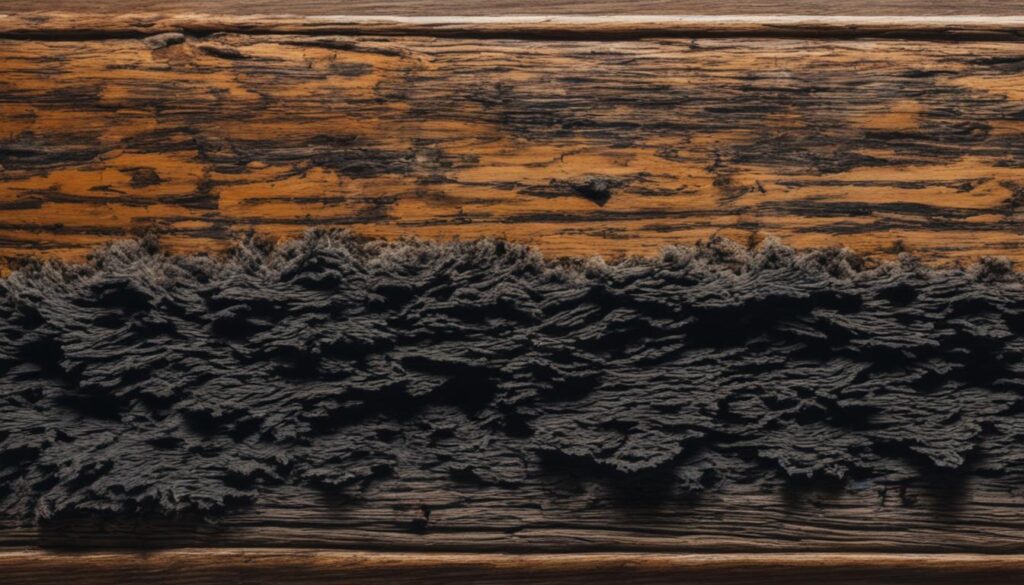
Additionally, it’s important to note that black mold removal can be a hazardous process that requires proper safety measures. Avoid directly handling mold or inhaling mold spores, and consider hiring a professional mold removal service to handle severe cases.
DIY Removal Methods for Black Mold on Wood
Black mold on wood can be a frustrating problem to deal with, but fortunately, there are several effective DIY methods for removing it safely. Follow these simple steps to get rid of black mold on wood:
Tools and Supplies
- Protective equipment such as gloves, goggles, and a mask
- Soft-bristled brush or sponge
- Bucket
- White vinegar
- Hydrogen peroxide
- Baking soda
- Water
Safety Precautions
Before starting the removal process, make sure to take proper safety precautions. Wear protective gloves, goggles, and a mask to avoid contact with the mold and the cleaning solution. Avoid disturbing the mold spores to prevent them from spreading and potentially causing health issues.
Cleaning Solutions
Depending on the severity of the mold infestation, you can use a combination of the following natural cleaning solutions:
| Cleaning Solution | Mixing Instructions |
|---|---|
| White vinegar | Mix equal parts vinegar and water. Apply to the affected area and let it sit for at least 30 minutes before scrubbing with a brush or sponge. Rinse with water and dry the surface thoroughly. |
| Hydrogen peroxide | Mix equal parts hydrogen peroxide and water. Apply to the affected area and let it sit for at least 10 minutes before scrubbing with a brush or sponge. Rinse with water and dry the surface thoroughly. |
| Baking soda | Mix 1 tablespoon of baking soda with a cup of water. Apply the mixture to the affected area and let it sit for at least 10 minutes before scrubbing with a brush or sponge. Rinse with water and dry the surface thoroughly. |
For tougher mold stains, you may need to try a combination of these solutions or repeat the cleaning process several times.
Finishing Touches
After removing the black mold, it’s important to take preventative measures to avoid future growth. Keep the area well-ventilated and free of excess moisture. Regularly inspect wooden surfaces for any signs of mold and immediately address any issues.
Professional Mold Removal Services
For severe black mold infestations on wood, hiring professional mold removal services can be highly beneficial. Wood mold remediation requires specialized expertise and equipment, and attempting to handle it DIY-style can lead to health risks and further damage to wooden structures.
Qualified mold removal companies have the training, experience, and certifications necessary to handle mold removal effectively and safely. They use state-of-the-art equipment to detect hidden mold, isolate contaminated areas, and prevent mold spores from spreading to unaffected areas.
When choosing a reputable mold remediation company, it is essential to look for certain qualifications and expertise. Check for certifications and accreditations from reputable organizations such as the Institute of Inspection, Cleaning and Restoration Certification (IICRC) and the National Organization of Remediators and Mold Inspectors (NORMI). Ask for references, proof of insurance, and guarantees for the quality of work.
Benefits of Professional Mold Removal Services
“Professional mold removal companies are equipped to handle severe mold infestations on wood effectively, providing peace of mind, safe living conditions, and long-lasting solutions.”
| Benefits | Explanation |
|---|---|
| Expertise and Experience | Professional mold remediators have extensive training and experience in handling mold infestations on wood surfaces. |
| Advanced Equipment and Techniques | Mold remediation companies use specialized equipment and techniques to detect, remove and prevent mold growth on wood surfaces. |
| Reduced Health Risks | Professional mold remediation services safeguard individuals from exposure to harmful mold spores, preventing respiratory issues and other health complications. |
| Long-lasting Solutions | Hiring a professional service provider guarantees long-lasting and effective solutions, reducing the likelihood of future mold infestations on wood surfaces. |
While professional mold removal services may be more expensive than DIY methods, they provide a safer, more effective, and more reliable solution for addressing severe mold infestations on wood surfaces.
Effective Treatment Solutions for Wood Mold
When it comes to eliminating black mold on wood, there are several effective treatment solutions available. These methods have been proven to get rid of mold and prevent its recurrence on wooden surfaces. Some popular treatments include:
- Bleach Solution: This is a commonly used treatment method for black mold removal on wood. Mix bleach and water in a 1:10 ratio, apply the solution to the affected area, let it sit for 15 minutes, then rinse with water.
- Vinegar: Like bleach, vinegar is also an effective wood mold treatment. Apply undiluted vinegar to the affected area, let it sit for an hour, then rinse with water.
- Borax: A borax solution is also effective for wood mold treatment. Mix borax and water in a 1:10 ratio, apply the solution to the affected area, let it sit for an hour, then rinse with water.
In addition to the above methods, there are also commercial products available for wood mold treatment. These products contain fungicides and other ingredients proven to eliminate mold and prevent its return on wood surfaces. Some popular brands of such products are Concrobium, Mold Armor, and RMR-86.
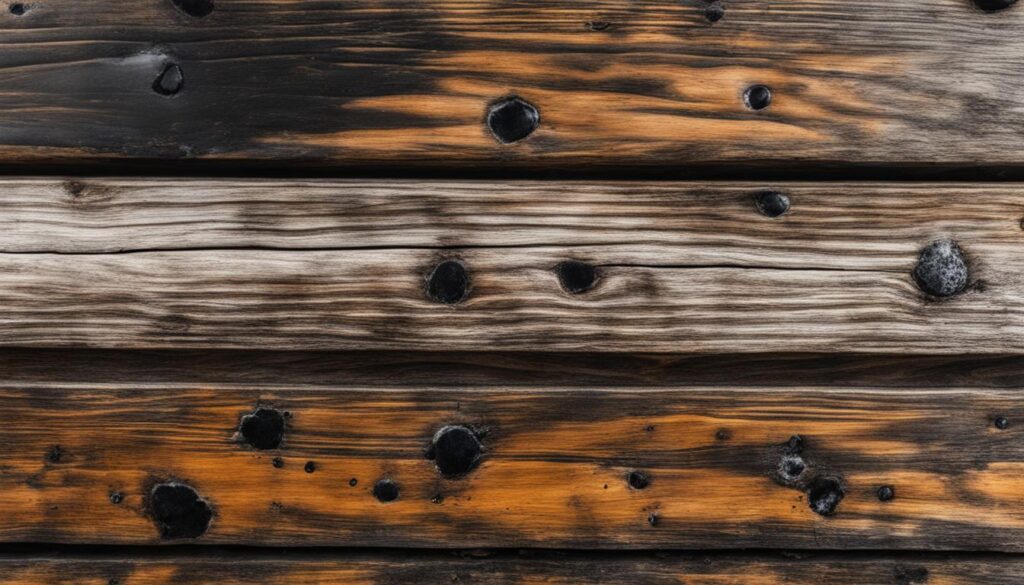
It’s essential to follow proper safety precautions when applying any treatment method for black mold on wood. Wear gloves and a mask to protect yourself from exposure. Ensure good ventilation in the area to avoid inhaling fumes.
Preventing Future Mold Growth on Wood
After effectively removing black mold from wood, taking steps to prevent future growth is crucial for safeguarding your wooden structures. Implementing practical tips and strategies can help ensure a mold-free environment and preserve the integrity of the wood.
Proper Ventilation
Good airflow and proper ventilation systems are essential in preventing mold growth on wood surfaces. Adequate ventilation helps to control humidity levels, reducing the likelihood of mold development. Ensure that vents and fans are regularly cleaned and maintained to facilitate proper airflow.
Addressing Water Damage and Moisture Issues
Water damage and excessive moisture are common causes of black mold on wood. To prevent mold growth, any water damage or moisture issues should be resolved promptly. This may involve fixing leaks, addressing plumbing issues, installing dehumidifiers, or sealing cracks and gaps to prevent water infiltration. Ensure any spills or moisture are promptly and thoroughly cleaned up and dried to avoid mold growth.
Regular Inspection and Maintenance
Regular inspection and maintenance play a vital role in preventing mold on wood. Routine checks can help identify potential mold growth early and enable prompt action. It’s important to control the moisture and humidity levels around wood surfaces, ensuring they are adequately ventilated and not exposed to excessive heat or moisture. Any deteriorating wood should be promptly replaced to prevent mold growth.
Effective Treatment Solutions
Effective treatment solutions can help eliminate mold and prevent its recurrence on wood surfaces. There are various products and methods available, including natural cleaners and commercial fungicides.
Note: Always read and follow the instructions provided by the manufacturer when using cleaning and treatment products. Wear protective gear, such as gloves and masks, when handling these products.
By implementing these strategies, you can successfully prevent mold growth on wood and maintain a mold-free environment for your family and occupants.
Regular Inspection and Maintenance
Regular inspection and maintenance are essential to preventing mold on wood. By identifying and addressing issues early on, you can avoid costly repairs and health hazards associated with black mold infestations. Below are some key maintenance tasks to keep in mind:
- Check for water damage: Water damage is one of the most common causes of mold growth on wood surfaces. Regularly inspect the areas around pipes, windows, and doors for signs of leaks, and have any issues repaired promptly.
- Monitor humidity levels: High humidity is another factor that contributes to mold growth on wood. Invest in a hygrometer to measure indoor humidity levels and use a dehumidifier if necessary to maintain levels below 60%.
- Inspect wooden surfaces: Routinely check wooden surfaces for signs of mold growth, such as discoloration, musty odor, and dampness. Promptly clean any affected areas with a mold removal solution to prevent further growth.
- Ensure proper ventilation: Proper ventilation is crucial in preventing mold growth on wood. Ensure that all rooms have adequate ventilation systems and use exhaust fans in high-moisture areas like bathrooms and kitchens.
- Have a professional inspection: Regularly schedule a professional mold inspection to ensure that your home or building is mold-free. A certified professional can identify any hidden mold growth and provide effective treatment solutions.
By incorporating these maintenance tasks into your routine, you can effectively prevent mold growth on wood surfaces and maintain a healthy environment in your home or building.
Understanding the Importance of Proper Ventilation
When it comes to preventing mold on wood, good ventilation is key. Proper airflow and humidity control are crucial factors in keeping wooden structures mold-free. Without adequate ventilation, moisture can accumulate and promote mold growth on wood surfaces.
Ventilation systems not only help to regulate moisture levels but also improve air quality. Insufficient airflow can lead to stagnant air, which can cause unpleasant odors and increase the likelihood of respiratory issues. In contrast, proper ventilation can promote a healthy indoor environment and prevent mold growth on wood surfaces.
To maintain good ventilation, it is important to ensure that all ventilation systems are clean and functioning properly. This includes air ducts, exhaust fans, and other mechanisms designed to circulate air. Regular maintenance and cleaning can help to ensure optimal performance and prevent the buildup of dirt, dust, and other contaminants.
In addition to proper ventilation, it is also essential to address any water damage or moisture issues promptly. Leaks or water intrusion can lead to excess moisture in wood surfaces, creating the perfect environment for mold growth. By addressing these issues quickly, you can prevent mold growth and maintain a healthy indoor environment.
The Benefits of Good Ventilation and Humidity Control for Preventing Mold on Wood:
| Benefits | How it Prevents Mold on Wood |
|---|---|
| Promotes good indoor air quality | Reduces the concentration of mold spores and other contaminants in the air |
| Regulates moisture levels | Prevents the buildup of excess moisture that can promote mold growth |
| Improves overall indoor comfort | Creates a more pleasant and healthy indoor environment |
Proper ventilation and humidity control are key to preventing mold growth on wood surfaces. By maintaining good airflow and addressing water damage promptly, you can protect your wooden structures from mold infestations and ensure a healthy indoor environment.
Addressing Water Damage and Moisture Issues
When it comes to preventing mold on wood, addressing water damage and moisture issues is crucial. Excessive moisture is a common cause of black mold on wood, as it creates an ideal environment for mold growth. The presence of water damages wooden structures, contributing to the growth of fungi, which can spread quickly without proper maintenance.
If you notice signs of water damage, such as discoloration, warping, or swelling, it’s essential to take immediate action. Here are some steps you can take:
- Identify and fix any plumbing or roof leaks that could be causing water damage.
- Regularly check for signs of moisture buildup, especially in humid or damp areas.
- Ensure proper ventilation in areas prone to moisture, such as bathrooms and kitchens.
- Invest in dehumidifiers or air purifiers to reduce humidity levels.
- Remove any standing water as soon as possible.
- Regularly inspect and maintain gutters and downspouts to prevent water accumulation around the foundation and walls of the building.
By addressing water damage and moisture issues promptly, you can prevent the growth of black mold on wood surfaces. Remember to practice regular maintenance checks and repairs to ensure a safe and healthy environment for you and your loved ones.
Conclusion
Black mold on wood surfaces can be a serious problem, but it can be effectively addressed and prevented with the right knowledge and proactive measures. By understanding the causes of mold growth on wood, focusing on effective removal methods, and implementing preventive strategies, you can ensure a mold-free environment and safeguard the integrity of your wooden structures.
Remember that for more severe cases or if you are unsure about handling the situation yourself, it’s best to consult with professional mold removal services. Regular inspection and maintenance, proper ventilation, and addressing water damage and moisture issues are all critical components of preventing mold on wood surfaces.
By following the tips and guidance provided in this article, you can protect the health and well-being of occupants and preserve the beauty and functionality of your wooden structures for years to come.
FAQ
What are the common signs of black mold on wood surfaces?
Black mold on wood can present itself through various signs, including discoloration, a musty odor, and a fuzzy or slimy texture. If you notice any of these indicators, it’s essential to take immediate action to address the issue.
How can I safely remove black mold from wood surfaces?
To remove black mold from wood, start by wearing protective gear, such as gloves and a mask, to avoid exposure. Then, scrub the affected area with a scrub brush and an anti-fungal cleaner or a mixture of water, detergent, and vinegar. After cleaning, dry the wood thoroughly to prevent moisture accumulation.
What are the common causes of black mold growth on wood?
Black mold on wood is often caused by factors such as high humidity, water damage, and poor ventilation. These conditions create a favorable environment for mold spores to thrive and grow on wooden surfaces. Taking preventive measures, such as controlling humidity levels and addressing any sources of water damage promptly, can help prevent mold growth.
Are there any health risks associated with black mold on wood?
Yes, exposure to black mold on wood can pose several health risks. It can cause respiratory issues, allergic reactions, and even more severe health problems in individuals with compromised immune systems. It’s crucial to address mold infestations promptly to protect the health and well-being of occupants.
What are some DIY methods for removing black mold from wood?
DIY removal methods for black mold on wood include scrubbing the affected area with anti-fungal cleaners or natural solutions like vinegar. You can also use a solution of hydrogen peroxide and water for more stubborn mold stains. Remember to take appropriate safety precautions and ensure proper ventilation while cleaning.
When should I consider hiring professional mold removal services for black mold on wood?
It’s advisable to hire professional mold removal services for more severe black mold infestations on wood or if you are unsure about handling the situation yourself. Professional mold remediation companies have the knowledge, expertise, and specialized equipment to effectively remove mold and ensure thorough remediation.
What are some effective treatment solutions for wood mold?
Various treatment solutions can effectively eliminate black mold on wood. These include using mold-killing products, such as borax or hydrogen peroxide, and applying anti-fungal sealants to prevent future mold growth. It’s essential to follow the manufacturer’s instructions and ensure proper ventilation during the treatment process.
How can I prevent future mold growth on wood surfaces?
Preventing mold growth on wood surfaces requires maintaining proper ventilation, controlling humidity levels, and addressing any water damage or moisture issues promptly. Regular inspection and maintenance, such as sealing cracks and improving insulation, can also help prevent mold infestations on wood.
Why is regular inspection and maintenance important for preventing mold on wood?
Regular inspection and maintenance are crucial in preventing mold on wood. By conducting routine checks, you can identify any signs of water damage, leaks, or humidity issues early on and address them promptly. Timely repairs and moisture control measures are essential in reducing the risk of mold growth on wood surfaces.
How does proper ventilation help prevent mold growth on wood surfaces?
Proper ventilation helps prevent mold growth on wood by promoting good airflow and reducing excessive humidity. It is essential to ensure that there is adequate ventilation in areas prone to moisture, such as bathrooms, kitchens, and basements. Installing exhaust fans, using dehumidifiers, and opening windows regularly can help maintain proper ventilation.
How should I address water damage and moisture issues to prevent mold on wood?
To prevent mold on wood, it’s crucial to address water damage and moisture issues promptly. This includes fixing any leaks, repairing faulty plumbing, and ensuring proper drainage around your property. It’s also important to monitor humidity levels and use dehumidifiers or moisture-absorbing products if necessary.

